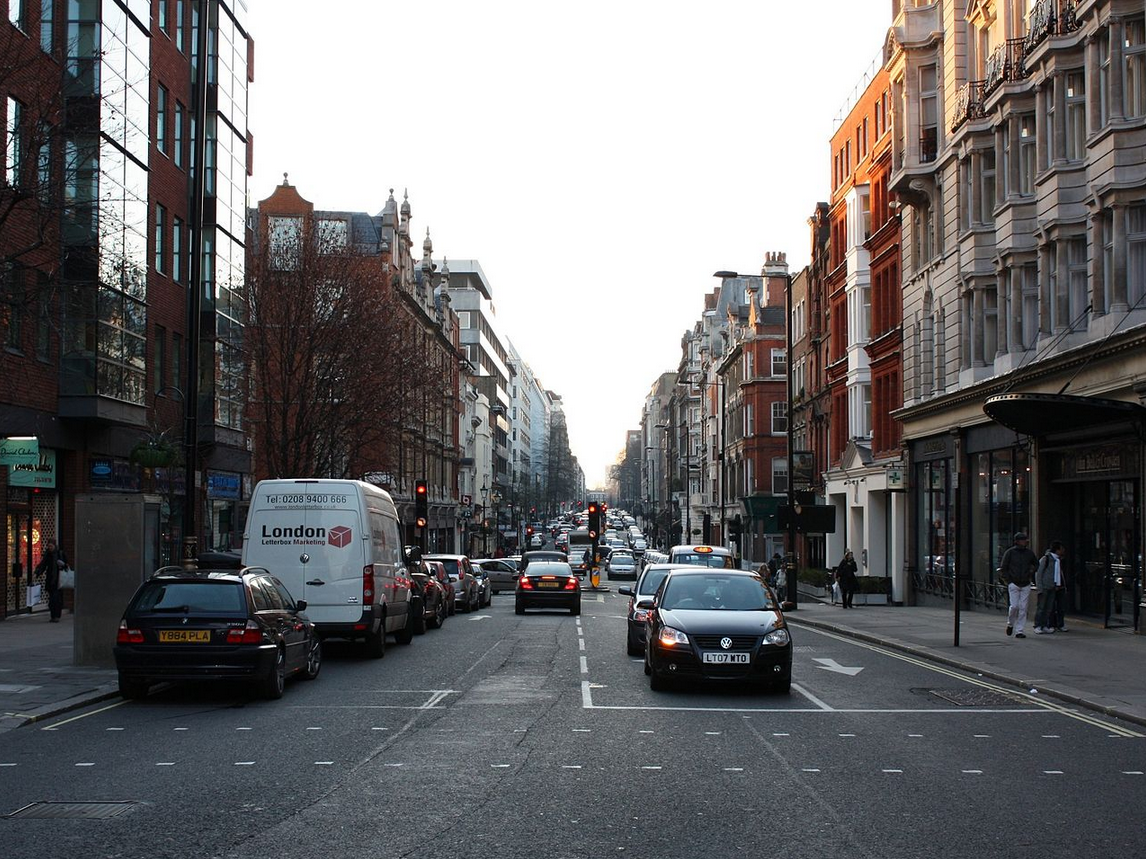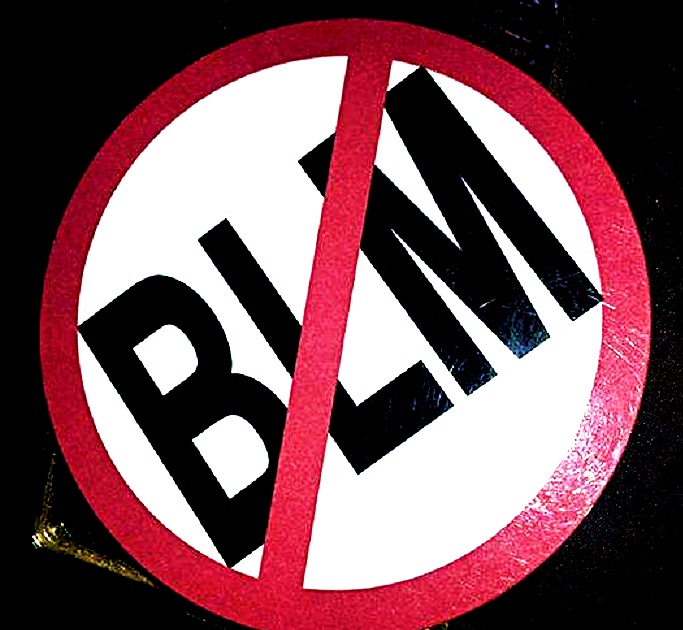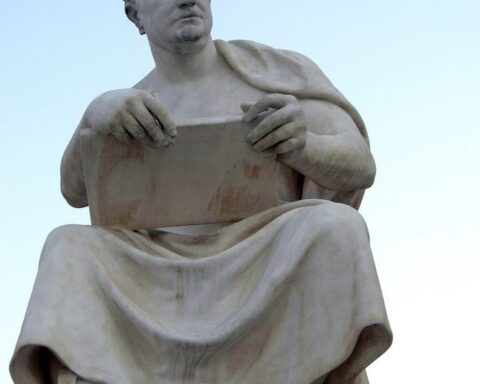Editor’s note: The following is extracted from Names and Their Meaning, by Leopold Wagner (published 1893). All spelling in the original.
At that remote period when the first rude huts were established on the banks of the Thames, the surrounding scene could have presented nothing more inviting to the eye than an extensive marsh or morass. That such was undoubtedly the case the existing names of Fenchurch Street and Finsbury, furnish ample evidence. The former marks the site of an ancient church situated among the fens, while the latter is an easy corruption of Fensbury, the Anglo-Saxon designation for “a town among the fens.” Therefore it was not surprising that the barbaric Britons, who founded what we now call London, should have given the name of Llyn-dun [see Lincoln] to their colony beside the Thames. Apropos of the Thames, the name of our noble river is merely a slight contraction of the Latin Thamesis, signifying “the broad Isis.” Isis is the Celtic for water.
Westminster was denominated after the Abbey [see Westminster Abbey]. Belgravia is the name given to the fashionable district of which Belgrave Square is the common centre. Pimlico owed its designation to an attempt on the part of the tavern-keepers of this neighbourhood to rival the celebrated nut-brown ales of one Ben Pimlico, who kept a pleasure-garden near Hoxton, the road to which was known as Pimlico Walk (still in existence), and the garden itself, first as “Pimlico’s,” and subsequently as “Pimlico.” The name of Knightsbridge carries us back to the time when two knights, on their way to receive a blessing from the Bishop of London at Fulham, engaged in a deadly combat on the bridge that spanned the Westbourne, exactly on the spot where Albert Gate now stands. Prior to this incident the bridge had borne the name of Fulham Bridge. Mayfair occupies the site of an annual six days’ fair held in May, originally at the instance of Edward I., for the benefit of the leper hospital of St. James the Less, Bishop of Jerusalem, now St. James’s Palace. The district of Soho was known by its present name as long ago as the sixteenth century; “So ho!” being the cry of the huntsmen when calling off their harriers in the days when the whole of London west of Drury Lane was open country. Bloomsbury is a corruption of “Lomesbury Village,” of which the Manor House stood on the site of Bloomsbury Square. Smithfield is a modern perversion of “Smoothfield,” an extensive tract of meadow land where horses were sold and tournaments were held as far back as the twelfth century. The first recorded English horse-race was witnessed in Smoothfield in the year 1154. Clerkenwell derived its name from an ancient well (now marked by an iron pump let into the wall at the south-east end of Ray Street) beside which the parish clerks performed their Miracle Plays. Spa Fields, now built over, owed their designation to a medicinal well, or Spa, discovered in 1206, and subsequently known as “The London Spa.” The proper description of Bunhill Fields is Bonhill, i.e., “good hill” Fields, so styled because the victims of the Great Plague were buried here in 1665. Moorfields was formerly a bleak moor skirting the northern portion of the marshy land known as Fensbury, now Finsbury, already referred to.
Shoreditch did not receive its name from Jane Shore, neither is the word a corruption of “Sewer Ditch,” as some writers have suggested. This district really comprised the manor of Sir John Soerditch, a wealthy London citizen and a valiant knight who fought by the side of Edward the Black Prince at Crecy and Poictiers. Whitechapel was designated after the White Chapel of St. Mary, built in 1673. Goodman’s Fields perpetuated the name of the owner of the land now known as the Minories, upon which a Priory of the Nuns of St. Clare was afterwards built. Shadwell is a corruption of St. Chad’s Well, discovered in this neighbourhood in ancient times. The once-notorious Ratcliffe Highway derived its name from the Manor of Ratcliffe, belonging to the adjoining parish of Stepney. The title has now been changed to St. George’s Street. Stepney was anciently described as Stebenhithe, signifying that it contained a wharf or haven belonging to one Steben or Steven. Spitalfields marks the site of the ancient Priory of St. Mary of the Spittle, dissolved in 1534. The French refugees established the silk manufacture here in 1685. Bethnal Green recalls the existence of the old family of the Bathons, whose history is first recorded in connection with their property situated in this neighbourhood during the reign of Edward I. Hoxton is a corruption of Hogsdon, meaning hog’s town. In proof of this statement we may add that Hog Lane still exists in the vicinity. De Beauvoir Town preserves the family name of the De Beauvoirs, whose original ancestor, Richard de Beauvoir, of Guernsey, resided here in princely style. Copenhagen Fields were so called after a tea-house opened by a Dane, about the time when the King of Denmark paid a visit to James I. Haggerstone is a corruption of “Hergotestan,” the literal Saxon for “Our God’s Town.” Hackney was originally described as Hackoneye, signifying an ey, or portion of well-watered pasture land, appropriated by a Danish chief named Hacon [see Chelsea, &c.].
Dalston is properly Daleston, or Vale-town. This was a quiet suburban village situated in a valley during the days when the northern districts of the Metropolis were more or less wooded—as witness Stoke Newington, or the new town in the meadow by the wood. The word Stoke comes from the Anglo-Saxon stoc, a wood or stockade; ton is the Old English for town, and ing the Anglo-Saxon for a meadow, also a family settlement. Southgate is expressive of the southern entrance to the enclosure, anciently known as Enfield Chase; and Kingsland the royal domain adjacent to it. Abney Park owes its name to Abney House, recently converted into a Conservative Club, but originally the residence of Sir Thomas Abney (born 1639, died 1722), Lord Mayor and a distinguished Nonconformist, knighted by William III. Dr. Isaac Watts died at Abney House in 1748. Green Lanes indicates the rural character of this neighbourhood in bygone times. Edmonton is properly Edmond’s-town. The name of Ball’s Pond is all that remains to remind us of the one-time existence of “The Salutation” house of call which had a pond for dog and duck sports, kept by John Ball. Mildmay Park is so called after Mildmay House, the family seat of Sir Henry Mildmay, who came into possession of the estate by his marriage with the daughter of William Halliday, an Alderman of the City in the time of Charles I. Muswell Hill is a slight corruption of Mustwell Hill, derived from the Latin mustus, new, fresh; because on this hill there was anciently discovered a well of clear, fresh water by the friars of St. John’s Priory, Clerkenwell, who had a dairy hereabouts. That portion of the hill which has been cut through for the construction of the line of railway to Enfield, Barnet, and the north, bears the name of The Hog’s Back, in allusion to its shape. The name of Wood Green is self-explanatory. Hornsey is a corruption of “Harringe,” or meadow of hares. Canonbury received its title from the residence of the Prior of the Canons of St. Bartholomew, built in this neighbourhood soon after the Conquest. Bury is Saxon for a town or enclosed habitation, equivalent to the Celtic don, and Old English ton. In days of old, Highbury contained a Priory of the Knights of St. John of Jerusalem, built in 1271. The establishment was called High-bury, because it stood upon higher ground than their previous residence which had borne the name of Tolentone, or lower town. Holloway reminds us that this was once a miry hollow between Highgate and Islington. Barnsbury is a corruption of Berners-bury, originally a manor belonging to Lady Juliana Berners, Abbess of St. Albans. Islington has always been a favourite suburb in modern times, and even our mediæval ancestors must have been delighted with its situation, lying high and dry beyond the fens and the sloughy neighbourhood of the “old bourne.” Its name signifies “the settlement of the Islings.”
King’s Cross derived its name from a wretched statue of George IV., set up in honour of his accession in 1820, and demolished to make way for the London terminus of the Great Northern Railway in 1842. The parish of St. Pancras is so called after the church dedicated to the boy-saint who was martyred by Diocletian in the early days of Christianity. Agar Town, now entirely swept away by modern improvements, was designated after William Agar, a miserly lawyer who acquired the lease of the land for building purposes in 1840. Somers Town is the property of Lord Somers, and Camden Town, of the Earl of Camden. Kentish Town was formerly written “Kestestown”; but even that was a corruption of “Kantelowes Town,” erected upon the Manor of Kantelowes. The modern spelling of this family name is Cantlowes. Primrose Hill is still a pleasant eminence whereon primroses grow, despite the encroachments of bricks and mortar all around. Highgate is a title expressive of the elevated situation of the village that sprang up around the toll-gate established on the common highway from Barnet to Gray’s Inn Road about the year 1400. Holly Village, Highgate, was so called by its foundress, the Baroness Burdett-Coutts-Bartlett, after her residence, Holly Lodge, hard by. Hampstead signifies a farmhouse or homestead. The word is Saxon: ham, a home, and stede, a place. In its wider sense, ham denotes a town. The western slope of Hampstead bears the name of Frognal, after Frognal Priory, an ambitious edifice built here by Memory-Corner Thompson (born 1757, died 1843), in imitation of Horace Walpole’s toy village on Strawberry Hill. Bishop’s Wood, Hampstead, comprised the private estate of the Bishop of London, at the time when that ecclesiastic resided at Highgate. Gospel Oak received its designation from the oak that marked the boundaries of Hampstead and St. Pancras, and under which, in accordance with an ancient custom, the Gospel was read once a year. John Whitfield is said to have preached under this oak. Chalk Farm is a corruption of “Chalcot Farm,” a picturesque farmhouse in whose vicinity duels were usually fought during the century gone by. St. John’s Wood was anciently a thickly wooded district sheltering an “Abbey of the Holy Virgins of St. John the Baptist.” Kilburn owes its name to the Kil, the Celtic word for a cell, occupied by “one Godwyne, a holy hermit,” beside the bourne, or brook. Maida Vale was so called in commemoration of the Battle of Maida, in which the English defeated the French, July 4, 1806. Marylebone does not signify “Mary the Good,” as the majority of Londoners imagine, but “St. Mary of the Bourne,” alluding to the church of St. Mary within sight of the bourne that ran from the hermit’s cell at Kilbourne down to Tyburn, or rather Twa-burne; so called because two different bournes, or streams, met in the neighbourhood where the Marble Arch now stands.
The name of Bayswater has undergone considerable change from the original. Not so very long ago the whole of this district was known as Bayswater Fields; during the last century it bore the name of “Bear’s Watering,” and previously that of Baynard’s Watering. By the last was meant the land dotted with pools held from the Manor of Westminster, by Ralph Baynard, the favourite of William the Conqueror, who resided at Baynard’s Castle, at Blackfriars, on the north bank of the Thames. These pools, together with the Tyburn were converted into what is now styled the Serpentine, owing to its form, in 1733. Paddington, originally written Padynton, was the settlement or town of the Pædings, a branch of the family who originally established themselves at, and gave their name to, Padendene, in Surrey. Westbourne Park derived its name from the west bourne, or stream, that wended its way from the hermit’s cell at “Kilbourne,” in the direction of the “Baynard’s Watering,” and thence, after passing under Fulham (or Knights’) Bridge, emptied itself into the Thames. Notting Hill is a corruption of Knolton Barn (Hill), a manor held by the De Veres, and subsequently by Robert Fenroper, an Alderman of the City, in the reign of Henry VIII. The name of Shepherd’s Bush once more puts us in mind of the pastoral character of the environs of London in the days gone by. Acton is an Anglo-Saxon name for “Oak town,” signifying the town built in the vicinity of the large Oak Forest. Gunnersbury denotes the town, or enclosed habitation, named after Gunylda, the niece of King Canute, who resided here during the Danish occupation of England. Kew was anciently described in documents as Kay-hoo, meaning a quay situated on a hoo, or hoe, the Scandinavian for a spit of land. Brentford signifies the ford over the Brent, a tributary of the Thames that takes its rise near Hendon. Isleworth means a manor beside the water. The first portion of the word comes from the Celtic, Isis, water; the second is Anglo-Saxon for a manor. Staines owes its name to the boundary stone (Saxon stane, a stone) by the river, which displays the words “God preserve the City of London.” The date of this stone is 1280. Kingston was designated after the King’s stone, now preserved within railings near the Town Hall, upon which the Saxon monarchs sat to be anointed. Shepperton is Old English for Shepherd’s Town, or the abode of shepherds. The name of Twickenham denotes a hamlet situated between two tributaries of the Thames. Richmond was anciently known as Sheen, a Saxon term for “resplendent,” in allusion to the palace erected by Edward I. When Henry VII. rebuilt the palace, after its destruction by fire in 1479, he changed the name of the village to Richmond, in perpetuation of his title of Earl of Richmond prior to ascending the throne. This king died here in 1509.
Chiswick is a corruption of “Cheoselwick,” derived from the Anglo-Saxon ceosel, sand, gravel, and the Teutonic wick, a reach, from the root waes, a moist meadow. Hammersmith was originally Hammersmeide, a Saxon village distinguished for the number of its smithies. The forename, Hammer, is Scandinavian for a village or small town. Kensington derived its name, or rather that of Kynsington, the Saxon for King’s meadow, with the Old English suffix ton, a town, from a royal residence erected here in very early times. Brompton was so called from the broom-trees that grew in the neighbourhood of this healthy ton or town. Chelsea is described in old documents as “Chevelsey,” meaning shingle island. The first portion of the word claims the same etymology as Chiswick, viz., ceosel, sand, gravel; while the suffix ey, or ea, is also Anglo-Saxon, derived from oe, the Scandinavian for running water. These terminals always indicate water, and not unfrequently an island, properly so called; as, for example, Anglesey, the Isle of the Angles. In the case of Hackney the terminal is expressive of a well-watered pasture, as has already been seen; whereas in the cases of Chelsea and Battersea the allusion is not merely to their proximity to the Thames, but to their partial isolation in ancient times from the adjacent land on account of the creeks and inlets of the river. Battersea, we may here remark, is described in Domesday Book as “the Manor of Patricesy”; but even this early name was a corruption of Petersey, or St. Peter’s-ey, because it had belonged to the Abbey of St. Peter’s, Westminster, from time out of mind. To return: Walham Green denotes a settlement of foreigners; wal, being a modification of wahl, the Celtic for foreign, and ham, the Old English for a home. Fulham was formerly written “Fullenhame,” the Anglo-Saxon for a habitation of water-fowl. Parson’s Green received its name from the parsonage in connection with Fulham Church that stood here previous to 1740. Percy Cross, Fulham, is a corruption of “Parson’s Cross,” referring to a cross on the roof of the parsonage on Parson’s Green. Putney was originally “Puttaney,” the Saxon for Putta’s Isle; whereas Wimbledon was Wibbandun, a Celtic term signifying the dun, or hill-fort, belonging to one Wibba. The name of Wandsworth denotes a manor watered by the Wandle. Lambeth is a corruption of “Loamhithe,” the Anglo-Saxon for haven of the loamy soil. Vauxhall is described in a document dated 1282 as the Manor of Faukeshall. As, however, this manor was originally held by Fulke de Breante soon after the Conquest, it is highly probable that the designation was more correctly Fulke’s Hall, afterwards corrupted into Faukeshall. The present spelling of the name may be traced back to the year 1615, when the Hall, or Manor House, was occupied by Jane Vaux.
Southwark is a modification of the Anglo-Saxon “Suthwerk,” and the Danish Sydrike, literally the south fortification. During the Danish occupation of England this was a very strong position. Bermondsey was anciently written Beormundsey, signifying that the ey, or strip of land intersected by creeks [see Chelsea, &c.], belonged to Beormund, a prominent Anglo-Saxon lord. Horselydown is properly Horsadown, so called because this district was originally a down used for grazing horses. Walworth was named in honour of Sir William Walworth, Lord Mayor in 1380, who resided here. The Borough recalls the fact that the inhabitants of London south of the Thames were Burghers, and, therefore, entitled to the rights and privileges of Corporation.
Rotherhithe is Saxon for red haven, alluding to the colour of the soil. The name of Deptford indicates the deep ford over the Ravensbourne, which is now spanned by a bridge. Greenwich means the green town, or, more precisely, the verdant settlement beside the wick, or reach of the river [see Chiswick]; whereas Woolwich was originally Hylwich, i.e., hill town. The Isle of Dogs is a corruption of “Isle of Ducks,” so described in ancient documents on account of the number of wild-fowl always to be found there. New Cross derived its name from “The Golden Cross,” a famous old coaching-house, rebuilt and renamed “The New Cross.” Lewisham is properly Leawreham, or meadow-home. Blackheath is a corruption of Bleakheath. Eltham was formerly written “Ealdham,” the Anglo-Saxon for the old home or dwelling, referring to the palace occupied by the English kings down to the time of James I. Catford is a contraction of Cattleford, signifying a shallow portion of the Ravensbourne easily forded by cattle. [The University town on the Isis received its present name of Oxford for a similar reason.] Beckenham denotes a home beside the beck or brook. Here again the Ravensbourne comes into notice. Sydenham means the home or habitation in the south. The names of Forest Hill, Norwood, a contraction of Northwood, and Westwood remind us that the whole of this district was formerly a large tract of wooded land. Dulwich is a corruption of Dalewich, the town in the dale. Honor Oak owes its designation to the boundary oak, under whose umbrageous shade Queen Elizabeth is said to have dined. Nunhead derived its name from “The Nuns’ Head,” a place of holiday resort for Londoners, dating back more than two hundred years. Peckham was originally Beckham, a home distinguished for its becks or brooks. Brixton is a corruption of the Anglo-Saxon “Brigestan,” the bridge of stone. Camberwell derived its name from a miraculous well discovered close by the parish church dedicated to St. Giles, the patron of cripples. Cam is Celtic for crooked. In this instance the word applies to the cripples, or rather to their patron saint. [On the other hand, the University town of Cambridge was so called from the bridge over the Cam, a river distinguished for its winding course.] Stockwell is in allusion to the well found in the stoc, or wooded place, in Anglo-Saxon times. Kennington means a settlement in the King’s meadow. One of the palaces of Henry VIII. stood here. Newington denotes the new town in the meadow. Finally, the name of St. George’s Fields was derived from the neighbouring church of St. George the Martyr.










Great read. Neal Stephenson’s Baroque Cycle trilogy provides some of this info in a fictional context, and is recommended.